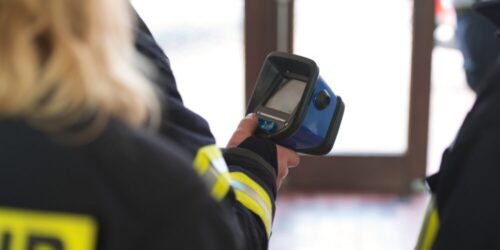There are many thermal cameras on the market for security uses. A thermal camera for fire detection needs to be designed for that purpose.

The National Fire Protection Association held its Annual Meeting and Expo in Las Vegas in June. From all appearances, it seems that there has been a full recovery from COVID-19. The expo hall was very busy all three days.
In walking through the hall, I noticed that there were a couple of firms that were showing thermal detection cameras. This is the first time that I noticed that cameras were being displayed that were designed for the detection of an incipient fire through the detection of temperature increase within the field of view.
I had a keen interest in this technology as I was just prior to the expo asked about using thermal cameras to detect a rise in temperature within a pile of recycled refuse.
In my article last year after visiting the Essen Security Expo in Germany, I reported that a manufacturer was showing a prototype thermal detection camera. Since the Essen show, this product has been developed to the point that it was a viable product.
Thermal detection cameras have been around for a number of years to be used as a portable instrument by the fire services to detect hot spots within the walls, flooring and ceiling of a building that has suffered a fire.
These cameras are used to make certain that all hot spots are found and knocked down so that a fire does not rekindle after the fire department has departed.
The Importance of Fire Detection Thermal Cameras
This article is not an endorsement of the two products that I will be covering, but is intended to provide information to the readership of other detection technologies that are coming into the market.
The first is from Optris. The firm primarily manufactures cameras designed for noncontact temperature measurements. This includes infrared thermometers. One industrial application is the monitoring of insulators on high-voltage transmission lines.
The line of thermal cameras the company offers for the detection of an incipient thermal event is very complex and these devices are not intended to be connected to a fire alarm control unit (FACU). Software and analytics is required.
Related: Fire Side Chat: The Differences Between NFPA 715 and NFPA 72
The camera feed is networked through a PC to provide a real-time image of events that may be occurring within the field of view.
Planck Vision Systems was the second manufacturer at the NFPA Expo showing off the latest in thermal detection camera technology. Its product was shown by Protectowire Fire Systems. Planck Vision Systems was the product that I saw at the Essen Expo in 2022.
This product also is not designed to connect directly into a FACU, but instead goes to a separate video display. The product also uses software that provides the analytics to produce an early warning of a thermal event.
Thermal cameras are not the same as a radiant energy detector, also known as a flame detector. These devices will not operate until the UV and IR signature of a flame is detected. A thermal camera will detect an increase of heat prior to a flame being produced.
The designer of a system needs to know which type of fire event is to be detected. A thermal camera would be used to detect a buildup of heat within a pile of trash to be recycled. A radiant energy detector would be used to detect a fast-moving fire developing from an aircraft within a hanger.
Both of these types of detectors have special requirements found within NFPA 72, National Fire Alarm and Signaling Code. One should consult with a fire protection engineer before using either of these detection methods.
When considering the use of a thermal camera for fire detection, the following should be reviewed:
- The specifications of the thermal cameras.
- Installation manual for the thermal cameras.
- The Listing for the thermal cameras.
- What is the size of the area the thermal cameras will be viewing?
- What is the calculated radiant energy absorption of the atmosphere within the space?
- Has the presence of extraneous sources of radiant emissions been considered?
- What is the ambient environment?
There are a number of thermal cameras on the market designed for security uses. A thermal camera to be used for fire detection needs to be designed for that purpose. It is one thing to detect a human moving across a field of view that has an ambient background. This is different than viewing a static image, looking for a gradual heat delta.
As mentioned, my interest in thermal cameras was for the detection of heat within a very large pile of trash. Other uses of a thermal camera include:
- Electric cars and lithium-ion batteries
- Sawdust and wood chippings
- Electrical power rooms
- Garbage bunkers
I believe that within the next five to 10 years this technology will expand and at some point able to be integrated directly into a fire alarm system.
About the Author

SHANE CLARY, SSI Contributor
Shane Clary, Ph.D., is Security Sales & Integration’s “Fire Side Chat” columnist. He has more than 37 years of security and fire alarm industry experience. He serves on a number of NFPA technical committees, and is vice president of Codes and Standards Compliance for Pancheco, Calif.-based Bay Alarm Co.
